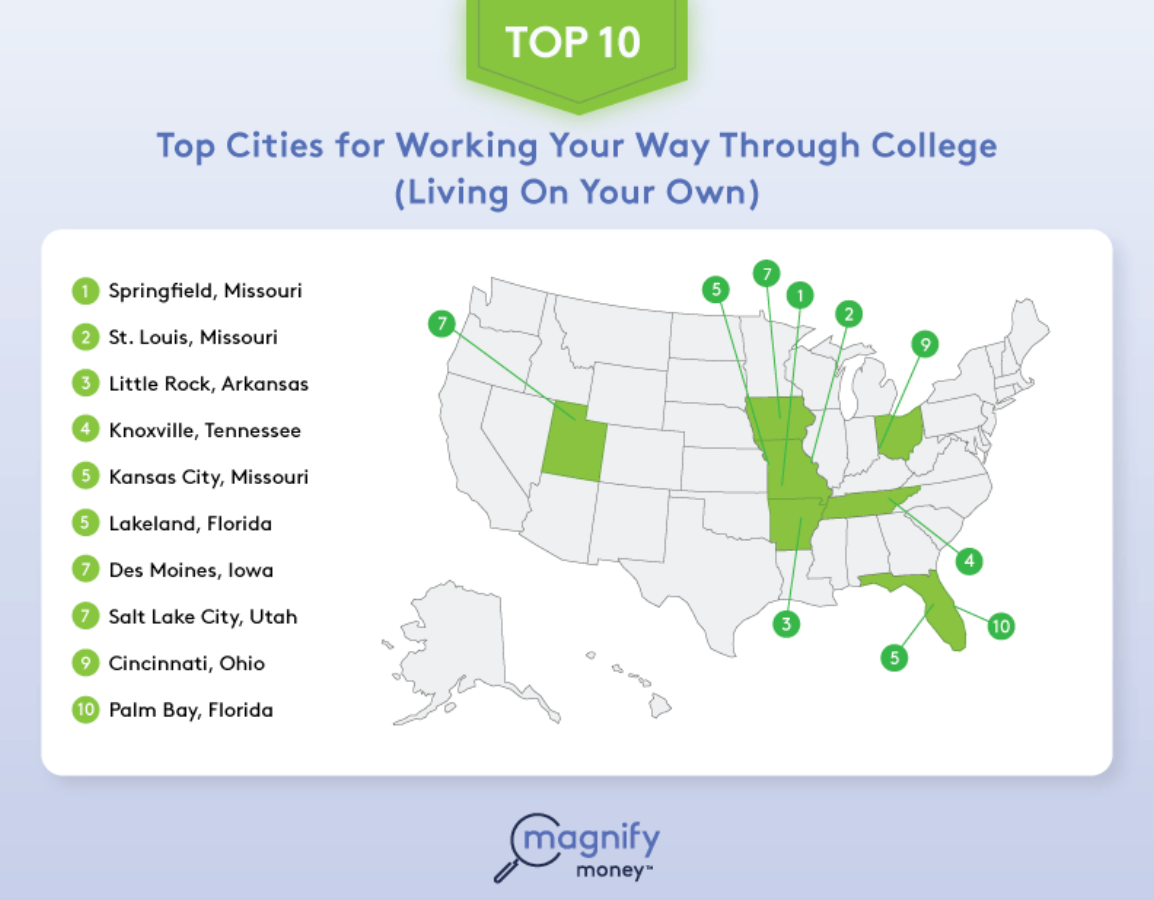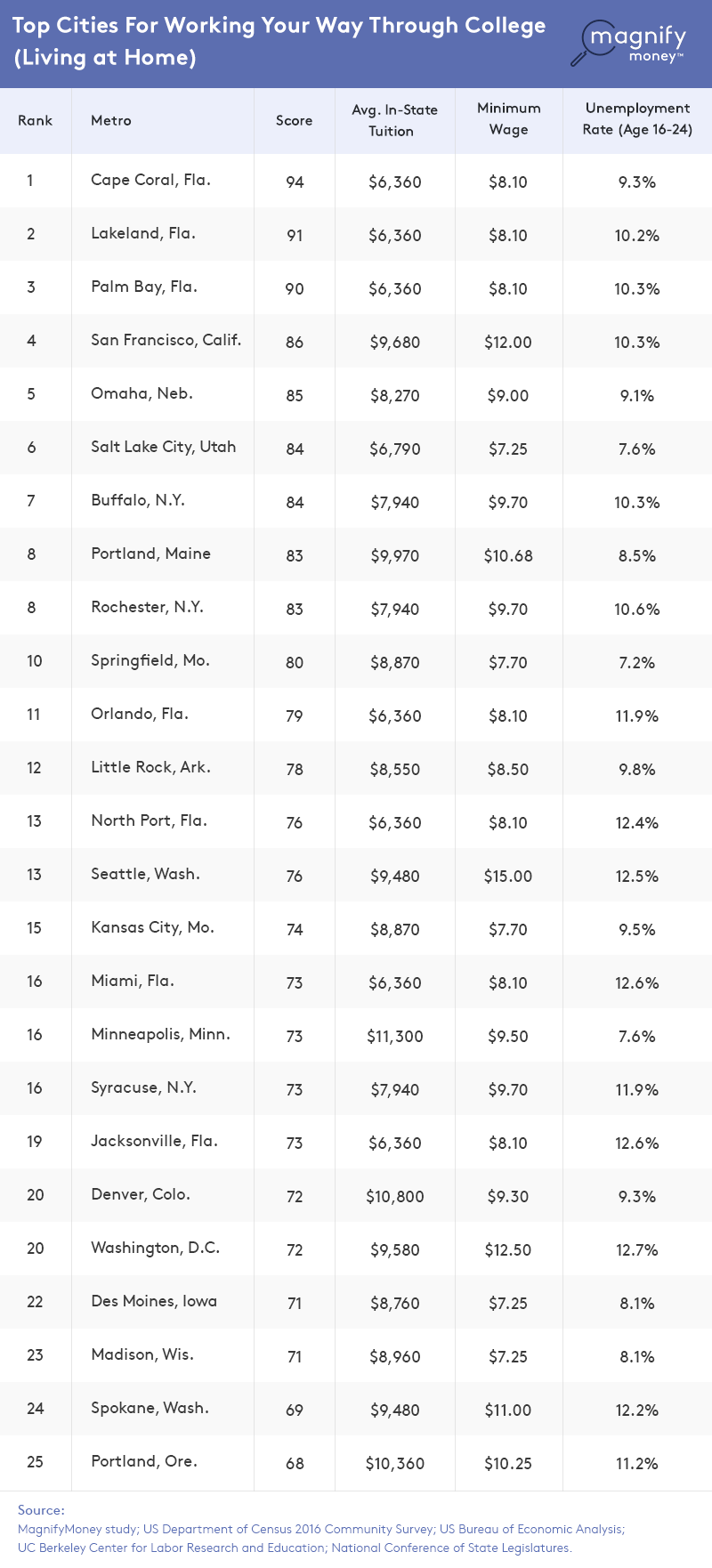Want To Avoid Student Loan Debt? These Are The States You Should Look At
The average cost of a four-year college education was almost five times higher in 2015 than a mere twenty years earlier, making the cost of an education seem out of reach for many. But, the data is clear: someone with a four-year college degree can expect to make $32,000 more a year than a high school graduate, or a whopping $1.4 million over the course of a working life. This forces American students (and their parents) into difficult and confusing decisions about how to approach a college education and what kind of student loans to take on.
It turns out that if you attend a public four-year university in one of these places, the days of working your way through college may not be over, despite common perceptions to the contrary. This is especially true when we consider that many, if not most, students are awarded various grants and scholarships to take the edge off an already (relatively) low in-state tuition.
A summer job doesn’t do it anymore, but a student who works – for minimum wage – about 20 hours a week while school is in session, 40 hours a week when it’s not, and takes a couple of well-deserved weeks off, can avoid student debt by paying off tuition in more places than you think, and may even have something left over for living expenses. Even if you earn enough to pay income taxes, spending your earnings on education can means substantial tax credits and deductions.
If You’re On Your Own…

There’s no question that working to pay your tuition bill is hard enough, but covering the basic costs of living on top of that can seem downright impossible. If you’re doing it yourself, these areas might offer a workable path to economic security. It takes a lot of work, but students can still pay off that tuition bill and the leftover income will go a lot farther towards necessities.
100 communities were scored on four factors: 1) Average rent compared to the rest of the country, 2) average cost of goods compared to the rest of the country, 3) the amount of average in-state tuition someone could pay off working 1,280 hours a year at minimum wage, and 4) the unemployment rate for people between the ages of 16 and 24 years old. A score of 51 represents the average score of the 100 largest Combined Statistical Areas we reviewed. The highest score is 76, and the lowest is 10.

1 – Springfield, Missouri
At just 7.2 percent, the Springfield-Branson area of Missouri boasts the lowest unemployment rate for young people among all of the communities we examined, and it’s the fifth cheapest place to live (McAllen, Texas is the cheapest, but that only gets it a score of 46, as youth unemployment is significantly higher than other places, state tuition is a touch higher than average, and the minimum wage is the lowest allowable by federal law). You can expect to pay 34 percent less in rent than your friends in the rest of America, and about $1,000 less in tuition. A minimum wage of $7.70 means you won’t have tons of money left over after paying your tuition (a student can earn about 111 percent of his or her full course tuition and fees), but you can buy more with what you do have.
Local public universities include Missouri State University. US News & World Report gives it a Regional Universities Midwest ranking of 106, reports that tuition for the 2017-18 academic year is lower than the state average at $7,060 (not including room and board), and notes admission is selective with an acceptance rate of 86 percent.
2 – St. Louis, Missouri
Both the first and third-ranked areas have lower average rents and youth unemployment rates than St. Louis, but a cost of goods that’s seven percent lower than the national average just edges this community to a higher score than Little Rock, Ark. Even so, the rent is an impressive 18 percent lower than the national average, and at 11 percent the youth unemployment rate is still about 13 percent less than the average of the communities we examined. Students can plan to earn about 111 percent of their full course load tuition. It’s also the most metropolitan area to place in the top 10, with a population of almost three million.
The big caveat is that this really only applies to people who live on the western side of the Mississippi River, because the average tuition in Illinois is the fifth highest in the nation at $13,620. Unfortunately, a student would only cover 72 percent of that by working for minimum wage.
Local public colleges and universities for Missouri residents include University of Missouri St. Louis. US News & World Report gives it national ranking of 231-300, reports that tuition and fees for the 2017-18 academic year were $10,275 (not including room and board), and notes that admission is “more selective” with an acceptance rate of 71 percent. At just over half the price, Harris-Stowe State University in St. Louis gets a US News & World Report Regional Colleges Midwest ranking of 62-80, has a reported 2017-18 academic year tuition and fees cost of $5,220 (not including room and board), and admission is designated “least selective” despite an acceptance rate of 55 percent.
3 – Little Rock, Arkansas
A comfortably low average state tuition, combined with a better-than-typical minimum wage of $8.50 (34th highest among the 100 communities we examined), means that students here can hope to have a bit of money left over, since they can earn about 127 percent of their full course load tuition. The cost of goods are four percent lower than the national average and rents that are 29 percent lower, which means that money you work so hard for can go further. The youth unemployment rate of 9.8 percent is also significantly less than our median rate of 12.5 percent. Finally, students also have more options than in some of our other highly scored areas, with three public four-year universities in the area.
Local public universities include the flagship campus of The University of Arkansas-Little Rock. US News & World Report gives it a national ranking of 231-300, reports that tuition for the 2017-18 academic year is $8,401 (not including room and board), and notes admission is “selective” with an acceptance rate of 77 percent. The University of Central Arkansas in Conway gets a Regional Universities South ranking of 72 from US News & World Report, and has a reported tuition for the 2017-18 academic year of $8,524 (not including room and board), and is considered selective with an acceptance rate of 90 percent. US News & World Report gives University of Arkansas-Pine Bluff a Regional Colleges South ranking of 50, reports that tuition for 2017-18 is $7,336, and note admission is less selective with an acceptance rate of 42 percent.

If You Live at Home…

Most college-bound kids dream of leaving home as soon as they can, but delaying gratification can have a big, long-term payoff if you’re from one of these areas. Who knows, maybe you even like your parents, or at least all the things they do and buy for you.
Low in-state tuition, youth unemployment rates, and high minimum wages give you the best chance of completely paying off your tuition by working part-time while school is in session and full time when it’s not. Statewide, Florida comes out on top, and even expensive places, like the Bay Area, get high scores thanks to higher wages.
These communities are scored on two factors: 1) the amount of average in-state tuition someone could pay off working 1,280 hours a year at minimum wage, and 2) the local unemployment rate for people between the ages of 16 and 24 years old. A score of 51 represents the average score of the 100 largest Combined Statistical Areas we reviewed. The highest score of the communities we examined is 94, and the lowest is nine.

1 – Cape Coral, Florida
2 – Lakeland, Florida
3 – Palm Bay, Florida
The bronze, silver, and gold all go to communities in the Sunshine State. That’s because Florida has a state-wide minimum wage right at the median for all the cities we reviewed and the absolute lowest average in-state tuition. Combine that with the low youth unemployment rates these three cities boast, and we see some A grades. If you were lucky enough to grow up in paradise, sticking around a little longer in the sun and surf isn’t just enticing – it’s the responsible financial choice. In all three places, you can expect to earn about 163 percent of your full course load tuition by working 1,280 hours at minimum wage. Another bonus? While Florida’s state universities have selective admissions, every single state college is open admission.
The three communities span the state from east to west, with Cape Coral on the Gulf Coast, Lakeland just east of Tampa, and Palm Bay nestled between extensive nature preserves and the Atlantic Ocean.

Just because you’re in paradise doesn’t mean the cost of living is as high as one might expect, either: the cost of goods is four percent lower than the national average. Cape Coral ticks just over the national average for rent.
In fact, the cost of living is so low in Lakeland, with rents a full 17 percent lower than the national average, it ties for the number five spot on our list of best places to work your way through college if you don’t live at home. In other words, even if your parents ask you to kick in some money for expenses, you should be okay.
Palm Bay comes in at eight percent lower rent than the national average, earning it the number 10 spot on our other list. The hitch is that the nearest public, four-year institution is about 40 miles away in Fort Pierce, but it may be worth it for a 2017-18 academic year tuition of – ready? – $2,640. Heck, you could pay the room and board of $5,700 and still come out better than most American students are paying for in-state tuition alone.
Local public colleges and universities in the Cape Coral-Fort Myers-Naples area include Florida SouthWestern State College (formerly Edison State College) in Fort Myers. US News & World Reports doesn’t give it a ranking, but notes that last year’s tuition was an astoundingly low $3,401. It is “least selective”, with an acceptance rate of 81 percent. Also in Fort Myers is Florida Gulf Coast University, which was awarded a Regional Universities South ranking of 73 by US News & World Report, which reports this year’s tuition and fees (not including room and board) is $6,118, and notes admission is “selective” with an acceptance rate of 56 percent.
Local public colleges and universities in the Lakeland-Winter Haven area include the University of South Florida in nearby Tampa. US News & World Reports gives it a national ranking of 140, and notes that it is “more selective” with an acceptance rate of 47 percent. Another option is Polk State College in Winter Haven. US News & World Reports doesn’t give it a ranking, but notes that last year’s tuition was an astoundingly low $3,366. It is “least selective”, and the acceptance rate isn’t available.
Unfortunately, you have to drive a fair distance to reach a public, four-year university near Palm Bay-Melbourne-Titusville, but if that’s doable, the closest schools include Indian River State College in Fort Pierce. US News & World Reports gives it a Regional Colleges South ranking of 60-79, reports that tuition and fees for this year is – just when you thought tuitions couldn’t get any lower — $2,640 (not including room and board). The school is “less selective” and has a 100 percent admission rate. If you’re willing and able to drive fifty miles, the University of Central Florida in Orlando gets a national ranking from US News & World Reports of 171, has a 2017-18 academic year tuition and fees (not including room and board) of $6,368, and is designated “more selective” with a 50 percent admission rate.
4 – San Francisco, California
Everyone knows the Bay Area in general, and San Francisco in particular, is one of the most expensive places in the world, so how can it come in fourth on a list of places where you can work your way through school? This community demonstrates the power of living in an expensive place – as long as someone else can cover your expenses – because higher costs can mean higher wages. San Francisco boasts a minimum wage of $14 and California has an average tuition rate of $9,680 for the current academic year, meaning a student can handily afford that tuition by working part-time during the school year and full-time during the summer. Combine that with a plethora of public schools – including world famous Berkeley – and prospective students might just learn to appreciate living with their parents a little longer. A student can expect to earn 159 percent of a full course load tuition.
Local public universities include one of the nation’s premier public universities, The University of California at Berkeley. US News & World Report gives it a national ranking of 21, reports that tuition for the 2017-18 academic year is higher than the state average at $14,098 (not including room and board), and notes admission is “most selective” with an acceptance rate of only 16 percent. For students who are just looking for something else, San Francisco State University gets a US News & World Report national ranking of 231-300, is actually cheaper than the state average, with a tuition for the 2017-18 academic year of $7,254 (not including room and board), and admission is “less selective”, with an acceptance rate of 68 percent. Other local public colleges and universities include California State University – East Bay in Hayward, and San Jose State University in San Jose.
Special Mention – Seattle, Washington
Seattle-Tacoma placed 13 on our list because its youth unemployment rate was at the median (and just slightly below average) of all the communities we examined. But if your teammate’s cousin’s girlfriend can hook you up with a job in Seattle proper, this community offers the best potential to cover tuition while working minimum wage of any community we rated.
You may remember when Seattle made headlines as the first place in America to raise minimum wage to $15 an hour, allowing locals to earn dramatically more than their peers around the country. With an average state school tuition of $9,480 (just under the nation’s median average in-state tuition of $9,580), working students can earn an amazing 203 percent of their full course load tuition costs… As long as they don’t have to pay their own living expenses. Despite the high minimum wage, Seattle didn’t fare well on our other list (ranking 81 out of 100), thanks to a high cost of living. Residents can expect to pay 26 percent more in rent than the average American, and even seven percent more for they stuff they buy.
Local public universities include the flagship campus of The University of Washington. US News & World Report gives it a national ranking of 56, reports tuition for the 2017-18 academic year is $10,974 (not including room and board), and notes admission is “selective” with an acceptance rate of 45 percent.

Methodology
For “On Your Own”, the top 100 Combined Statistical Areas by population were ranked against all examined CSAs according to the following characteristics:
- Percentage of average in-state tuition a student could expect to pay working 1,280 hours a year at minimum wage. ((1,280 x [local minimum wage]) / [average in-state tuition])
- Unemployment rate for the population aged 16 – 24
- Average rent price parity
- Average goods price parity
The score is sum of all ranked parts (equally weighted) divided by four, for a total possible score of 100 and a lowest possible score of four, and then rounded to the nearest integer. Final rankings are determined by the sum of all ranked parts, prior to division by four.
For “Living at Home”, the top 100 Combined Statistical Areas by population were ranked against all examined CSAs according to the following characteristics:
- Percentage of average in-state tuition a student could expect to pay working 1,280 hours a year at minimum wage. ((1,280 x [local minimum wage]) / [average in-state tuition])
- Unemployment rate for the population aged 16 – 24
The score is sum of all ranked parts (equally weighted) divided by two, for a total possible score of 100 and a lowest possible score of two, and then rounded to the nearest integer. Final rankings are determined by the sum of all ranked parts, prior to division by two.
Notes: Average rent and average cost of goods are the weighted (by youth population, ages 16-24) averages of those averages within component MSAs. Where there were multiple tuitions or/and minimum wages within a CSA, the lead city or state was used, except for the San Jose-San Francisco-Oakland, CA CSA, where the minimum wage for San Francisco was used. The youth unemployment rate was calculated on the CSA level as the total unemployed population aged 16-24 divided by the total civilian population aged 16-24 in the labor force.
We assume that our hypothetical students would have at least 100 percent of their federal taxes refunded, but recognize that personal and family circumstances differ, and there may be substantial changes to tax policy.
References:
- “Figure 6: 2017-18 Tuition and Fees at Public Four-Year Institutions by State and Five-Year Percentage Change in In-State Tuition and Fees,” CollegeBoard, October 2017. Available at: https://trends.collegeboard.org/college-pricing/figures-tables/2017-18-state-tuition-and-fees-public-four-year-institutions-state-and-five-year-percentage (retrieved November 27, 2017).
- American FactFinder Community Survey, US Department of Census, 2016.
- “State Minimum Wages / 2017 Minimum Wage by State,” National Conference of State Legislatures, January 5, 2017. Available at: http://www.ncsl.org/research/labor-and-employment/state-minimum-wage-chart.aspx (retrieved November 27, 2017).
- “Inventory of US City and County Minimum Wage Ordinances”, UC Berkeley Labor Center, November 16, 2017. Available at: http://laborcenter.berkeley.edu/minimum-wage-living-wage-resources/inventory-of-us-city-and-county-minimum-wage-ordinances/ (retrieved November 27, 2017).
- Table 6. Regional Price Parities by Metropolitan Area, 2015, “Real Personal Income for States and Metropolitan Areas, 2015”, Bureau of Economic Analysis, June 22, 2017. Available at: https://www.bea.gov/newsreleases/regional/rpp/2017/pdf/rpp0617.pdf (retrieved November 27, 2017).
- “Tuition costs of colleges and universities”, National Center for Education Statistics Fast Facts. Available at: https://nces.ed.gov/fastfacts/display.asp?id=76(retrieved November 27, 2017).
- Philip Trostel, “Beyond the College Earnings Premium. Way Beyond.”, The Chronicle of Higher Education, January 29, 2017. Available at: https://www.chronicle.com/article/Beyond-the-College-Earnings/239013 (retrieved November 27, 2017).
- “Upcoming Minimum Wage Increases”, New York State Department of Labor. Available at: https://labor.ny.gov/workerprotection/laborstandards/workprot/minwage.shtm (retrieved November 27, 2017).
- “Best Colleges” rankings, US News & World Report. Available at https://www.usnews.com/best-colleges (retrieved December 5, 2017).






